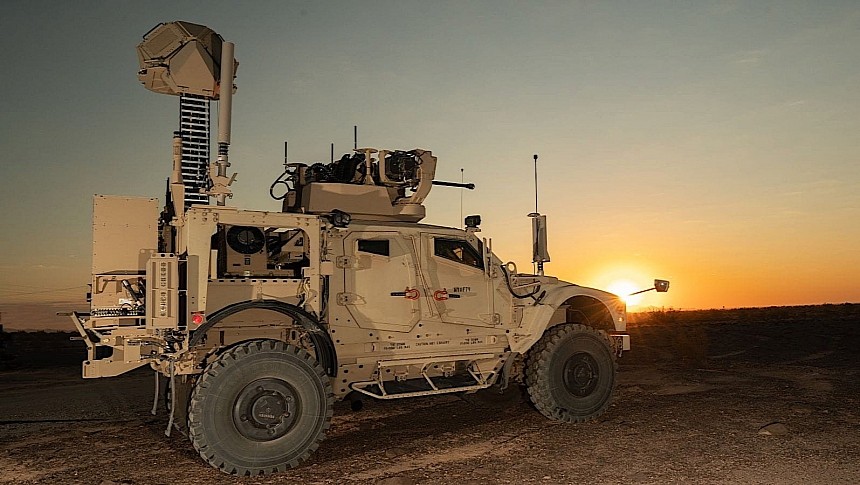In a very short period of time drones have become some of the deadliest and most widespread weapons on the battlefields of the world. And I'm not talking here about the big, military ones we already know to fly for years now, but about the small, even off-the-shelf solutions that can be adapted for warfare use in a heartbeat.
Such drones, impossible to detect and stop by conventional means, can prove deadly for infantry, but also tanks and other military gear and installation. The war in Ukraine more than proved that, and things will probably get even more complicated as time goes by.
The American military is currently researching several solutions to this problem. One of them is the so-called Low, slow, small-unmanned aircraft Integrated Defense System (LIDS).
As part of this research, defense contractor Raytheon demonstrated this summer a piece of technology called KuRFS. That's short for Ku-band Radio Frequency Sensor, a radar technology "that senses incoming drones, rockets, artillery and mortars."
The system was initially developed to provide a layer of defense against such threats for soldiers fighting in Iraq and Afghanistan. It was first used back in 2013, and has since grown to a total of 1.6 million operational hours.
It can be installed on a variety of vehicular platforms, and can be used to control and direct a wide range of weapons, including the Phalanx Weapon System, 50-caliber guns, and 30 mm cannons.
For defense against drones it can work in conjunction with the Coyote weapons system. That would be another Raytheon tech that is itself a drone.
The KuRFS works by means of active electronically scanned array, meaning it comprises a rather large number of small antennas instead of a single, larger one. This allows for better beam control.
Separately, the Ku-band of the electromagnetic spectrum allows operators to get higher-resolution imaging of the targets being tracked, and it even has the ability to keep tabs with birds flying in its area of operation.
The KuRFS – Coyote setup was at the center of the Army's summer tests, and judging by what we're told, all test requirements against high-speed, maneuvering targets have been met.
In words we can all understand, the system proved it is capable of tracking not only individual drones, but swarms of them. More then 30 targets fell under the system's scrutiny, and Coyotes were then directed to take them out.
As per a contract it awarded Raytheon back in 2022, the U.S. Army plans to equip two of its divisions with LIDS. Earlier this year, another contract was awarded targeting a third Army division. On top of that, the company says there is increased interest in the technology from international partners as well.
The American military is currently researching several solutions to this problem. One of them is the so-called Low, slow, small-unmanned aircraft Integrated Defense System (LIDS).
As part of this research, defense contractor Raytheon demonstrated this summer a piece of technology called KuRFS. That's short for Ku-band Radio Frequency Sensor, a radar technology "that senses incoming drones, rockets, artillery and mortars."
The system was initially developed to provide a layer of defense against such threats for soldiers fighting in Iraq and Afghanistan. It was first used back in 2013, and has since grown to a total of 1.6 million operational hours.
It can be installed on a variety of vehicular platforms, and can be used to control and direct a wide range of weapons, including the Phalanx Weapon System, 50-caliber guns, and 30 mm cannons.
For defense against drones it can work in conjunction with the Coyote weapons system. That would be another Raytheon tech that is itself a drone.
The KuRFS works by means of active electronically scanned array, meaning it comprises a rather large number of small antennas instead of a single, larger one. This allows for better beam control.
Separately, the Ku-band of the electromagnetic spectrum allows operators to get higher-resolution imaging of the targets being tracked, and it even has the ability to keep tabs with birds flying in its area of operation.
The KuRFS – Coyote setup was at the center of the Army's summer tests, and judging by what we're told, all test requirements against high-speed, maneuvering targets have been met.
In words we can all understand, the system proved it is capable of tracking not only individual drones, but swarms of them. More then 30 targets fell under the system's scrutiny, and Coyotes were then directed to take them out.
As per a contract it awarded Raytheon back in 2022, the U.S. Army plans to equip two of its divisions with LIDS. Earlier this year, another contract was awarded targeting a third Army division. On top of that, the company says there is increased interest in the technology from international partners as well.






